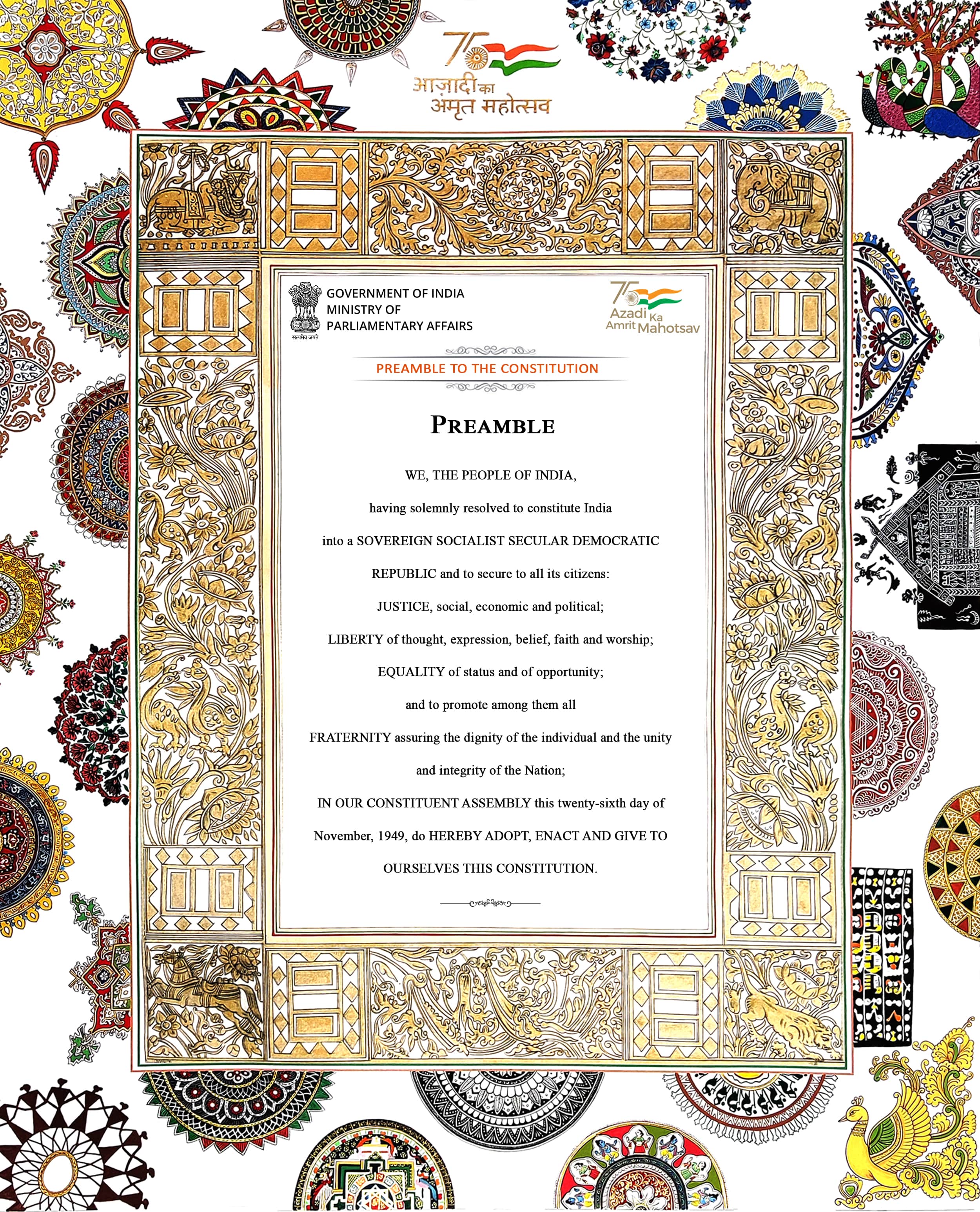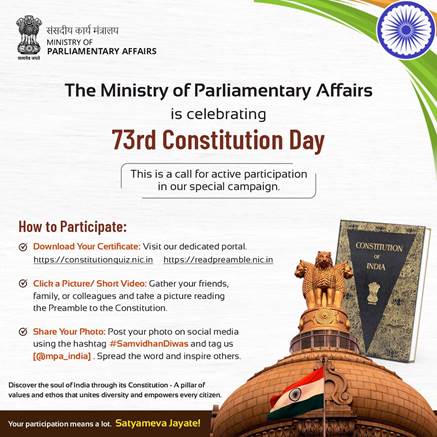Constitution Day
Constitution Day
November 26 is celebrated as Constitution Day (Samvidhan Divas) to commemorate the adoption of the Constitution of India. On 26th November 1949, the Constituent Assembly of India adopted the Constitution of India, which came into effect from 26th January 1950.
The Ministry of Social Justice and Empowerment on 19th November 2015 notified the decision of Government of India to celebrate the 26th day of November every year as 'Constitution Day' to promote Constitution values among citizens.
About the Indian constitution
 Need for Constitution in a Democracy
Need for Constitution in a Democracy
- In a democracy, the Constitution is a sacred text for the Government- It lays a strong foundation for a parliamentary democracy to function.
- The Constitution is the supreme law of a Nation
- India is the largest democracy in the world, and its Constitution serves as a guiding light for it to function smoothly and vibrantly.
- Ever evolving, the Constitution of India is dynamic and adapts itself to changing times, to address the changing needs and requirements of a developing nation.
Definition, Structure & Key Features
- The Constitution of India is the foundational law laying down the basic political structure of India – i.e. a Parliamentary Democracy and a Republic with a Federal Structure
- It defines the 3 organs of the Republic of India – the Executive, the Legislature and the Judiciary and clearly defines their power as well as demarcates their responsibilities
- It is the World’s Longest : The original copy of the Indian Constitution is 251 pages long- it is the most detailed in the world
- Contents : It contains 395 Articles, 22 Parts and 12 Schedules
- Amendments : It has undergone 103 amendments till date
Interesting Facts about Indian Constitution
 The Indian Constitution is completely hand-written and designed
The Indian Constitution is completely hand-written and designed- Sh. Nand Lal Bose, a pioneer of modern Indian Art, designed the borders of every page of the Constitution and adorned it with art pieces.
- Sh. Prem Behari Narain Raizada, a master of calligraphic art, singlehandedly handwrote the Constitution.
- Although it took him 6 months to complete the task, yet he charged no money for his work.
- The original manuscript of the Constitution was written on parchment sheets measuring 16X22 inches having a lifespan of a thousand years! It weighed 3.75 kgs.
- The Indian Constitution’s name is borrowed from the US. Its positions and functions is borrowed from the British Constitution
- The Constituent Assembly (CA) was set up in 1946 set up under the Cabinet Mission Plan of 1946. The Assembly held its first meeting on December 9, 1946, and elected Dr. Sachhidanand Sinha, the oldest member of the Assembly as the Provisional President. On December 11, 1946, the Assembly elected Dr Rajendra Prasad as its permanent Chairman.
- The CA took 3 years (1946-49) to complete the drafting
- The CA had 299 elected members from Provincial Legislative Assemblies
- The CA had 13 committees including the drafting committee
- The Constitution was adopted in 1949 when 284 members signed it, marking the completion of the Constitution making process
Founding Fathers of our Constitution
- Dr. Rajendra Prasad
- President of the Constituent Assembly.
- Elected as the first President of independent India On 24th Jan 1950, at the last session of the Constituent Assembly
- Distinction of being the only President to have been re-elected for a second term (1950-1962).
- Dr B.R. Ambedkar
- Referred to as the ‘Father of the Constitution’, Dr Ambedkar played a leading role in the Constitution’s framing process
- He was the Chairman of the Assembly’s most crucial committee - the Drafting Committee.
- He was directly responsible for preparing the draft Constitution for Independent India.
- Appointed as the first Law Minister of independent India in 1947.
- Sardar Vallabh Bhai Patel
- Sardar Vallabhbhai Patel was a key member of the Constituent Assembly
- He was instrumental in the integration of over 500 princely states into the Indian Union.
Observance of the Constitution day
As part of the celebrations, a number of activities aimed at highlighting and reiterating the values and principles enshrined in the Constitution are being organised. An important part of the celebrations is the reading of the Preamble to the Constitution and reaffirming our commitment to uphold its ideology.
Preamble of the Constitution
The Preamble is a brief introductory statement setting out guidelines for the people of the nation as well as presenting principles of the Constitution. It is the preface which highlights the entire Constitution and embodies fundamental values, philosophy & ethos on which our Constitution is based and built. It includes Fundamental Rights (Liberty of thought, expression, belief, faith & worship) and Fundamental Duties (Justice, social, economic & political). The whole edifice of the Constitution and structure of the political system protect and promote constitutional values embodied in the Preamble
WE, THE PEOPLE OF INDIA, having solemnly resolved to constitute India into a SOVEREIGN SOCIALIST SECULAR DEMOCRATIC REPUBLIC and to secure to all its citizens:
JUSTICE, social, economic and political;
LIBERTY of thought, expression, belief, faith and worship;
EQUALITY of status and of opportunity;
and to promote among them all
FRATERNITY assuring the dignity of the individual and the unity and integrity of the Nation;
IN OUR CONSTITUENT ASSEMBLY this 26th day of November, 1949, do HEREBY ADOPT, ENACT AND GIVE TO OURSELVES THIS CONSTITUTION
Constituion of India in Indian languages
To access the Constitution of India in Indian languages, click here.
Quiz on Constituion of India
To commemorate Samvidhan Diwas (Constitution Day), the Ministry of Parliamentary Affairs invites all citizens to participate in the Constitution Quiz - Bharat - Loktantra ki Janani and to get a certificate. To access the quiz, click here..
Last Modified : 7/26/2024
This section gives information about various Judic...
Learn about the Indian Constitution (Preamble, All...
Provides a brief of Life, History & Works of Baba ...
